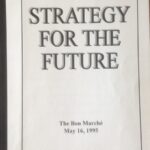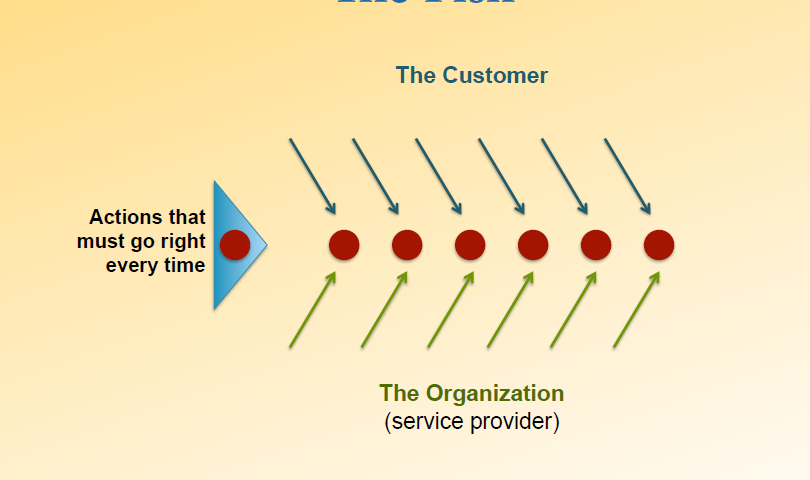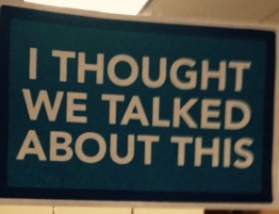Understanding the Problem Before You Decide on the Solution
March 15, 2015
Creating a Message System that Builds the Brand
March 17, 2015
DEFINING A BETTER WAY TO OPERATE
The Transactional Analysis and Behavioral Alignment System
INTRODUCTION
I’d like to discuss what I think is a major issue facing most of American businesses and government agencies: the fact that we as Americans are becoming more divisive, cynical, angry, and disconnected than at any other time in the last 50 years…
We are now confronted with the fact that major questions are being fought over by groups of people with polarizingly strong core beliefs, and these groups have become convinced that Their answer to the question is the only right answer; dialogue, listening and compromise have been replaced with blaming, yelling, and “my way or no way”.
Greed seems to be rewarded and celebrated with no regard to impact on everyone else. The value of the common worker is now being treated more as capital expense than a valued asset.
When things go wrong – we seem focused on assigning blame, not toward solutions and discussion on how should we fix or improve the situation. I could go on, but I think you get my point.
IMPACT OF SOCIAL MEDIA
A change has taken place in the way we communicate; the Social Media revolution and the fact the we are now all walking around with a hand held device which is more of a computer than phone, has created a generational divide as to what a discussion is:
- Conversation for younger people is a trail of text messaging.
- Twitter has created a substitute for a paragraph of information. Now it’s a short group of words
- Everyone with an opinion now has more ways to “go viral”. Yelp ratings, Angie’s list and Google searches give instant hits on how the business has been rated, directly influencing how new customers perceive the business being evaluated.
The question then becomes:
“In this current environment, how do you create a culture of Employees and Customers who are Loyal and Active Evangelists for supporting your business?”
ROADBLOCKS FOR AMERICAN BUSINESS & GOVERNMENTAL AGENCIES
As we try to define this question, I would like to first define what I think is a major issue facing American Business and Governmental Agencies.
I became interested in the concept of culture and leadership while I was at the University of Washington as a college basketball player: how do you get 12 young men to understand the coach’s system and play their role in helping the team be successful?
I received 2 extra years of University education, earning my MBA while acting as the graduate assistant basketball coach, and I decided when it came time to write my thesis to focus on what then was called “Theory X vs. Theory Y”, or democratic vs. autocratic leadership.
I contrasted the coaching styles of two great college coaches: Marv Harshman and Tex Winter, both hall of fame coaches. Coach Harshman tailored his system to match the skills and talent of his players, while Coach Winter only allowed the players to work within his system. I discovered that both styles could be very successful and that the real issue was getting the players to “own” the system and be accountable for playing their role within that system.
I have found the same to be true for regular business and government employees. I am now going to describe my view of a system that develops a culture of employees and customers who are Loyal, and who become active Evangelists for supporting your business.
I am calling this the Transactional Analysis Behavioral Alignment Operating System. First, I will describe how this system works, and then I will recount a few culture change experiences that will bring this system to life.
TRANSACTIONAL ANALYSIS BEHAVIORAL ALIGNMENT OPERATING SYSTEM
This System is grounded in 2 basic concepts:
- The 1st is the discussion of people’s attitudes and the impact on how they behave. We have all worked with people who seem to have bad attitudes, and have watched managers try to ignore or deal with these individuals. In most cases the effort is disruptive and many times divisive to the other employees. I believe that having clearly defined Behaviors that are understood and rewarded, will take care of any and all attitude issues.
- The 2nd core concept is that in any business /governmental operation, every activity is managed through a series of human transactions. The key is to make sure during each of these transactions that the core behaviors are clearly identified and defined, so that there are clear expectations as to how people should manage their behavior.
This is actually a very simple process; so let me tell you a story that will help you understand this process.
Experience
Virginia Mason – Helping to Re-Do a Clinic
I was asked by my personal physician if I would participate in a one-week brainstorm to help totally rework a Virginia Mason Medical Clinic. Because the Kirkland Clinic was moving to a new location, there was a chance to radically re-organize the way the Clinic worked. Virginia Mason has a very large investment in looking at their business (a hospital and 12-15 clinics) through the eyes of Toyota University: lean, efficient and very user-driven.
We started this 1-week brainstorm with an end in mind: greater efficiency for everyone, including the doctors, nurses, specialists, and lastly (why I was there), for the customer. In the end, it was an amazing week. For 5 days, 25 people (doctors, nurses, clinic manager, architects, everyone in the business) went through this very formal process to:
- Cut the number of steps a doctor and nurse walk by 50%
- Manage the supply of all the medical things needed to do their work with a just-in-time approach
- Let the patients become a bigger part of the system
So there I was, experiencing a discovery process that used the Toyota Production improvement method to re-engineer the entire way a medical clinic operated. The end of this story is that the VM Kirkland Clinic opened in March of 2009, and has accomplished everything that it set out to do with regard to improving efficiency. As expected, some of the older patients had some trouble with the changes – one of the efforts was to eliminate the clinic waiting rooms, as efficiency means no waiting. As the patient representative, I was not old enough to understand that older patients go to their medical clinics weekly and they like to talk to other weekly visitors at the clinic. Oh well, so much for efficiency.
The basic tool to design the space was a concept they called the “Fish”, which really was just a process of engagement – thinking through a transaction and defining all of the steps that the patient needed to do and matching those transaction points with what the clinic employees had to do.
In this diagram, there are two sides – the patient (customer) and the organization. The steps involved for each side are listed to examine efficiencies. For example:
- Patients have to park, so the Clinic had to think about what getting into the parking lot was like, and how big the stalls should be for their patients, and how do older people get out of their car, then get into clinic, etc.
- The next transaction interaction was checking in – what does the patient do and what could be done to ensure when they showed up, the checking in process was efficient.
- When the appointment reminder call was made, what could be done to ensure their visit went well – both efficient and create an outstanding experience.
On and on – every step in the patient’s visit and every system in the clinic’s business operation went through a “fish” process. Notes were kept, priorities were established, and policies, procedures and behaviors were defined.
Learning #1 – You can look at any operational transaction and create a transaction “fish” approach to understanding what behaviors, policies and procedures must go right every time for the user to have an outstanding experience.
Learning #2 – You can involve your employees and customers in defining the behaviors of “the fish” to add real insight and valuable consciousness to how things should work more efficiently, and how to create a dynamic and measurable experience for the user.
Learning #3 – This process transfers ownership to the employees – they become vested in not only how it should work, but also as the behaviors become the work standard, they champion the cultural change in the organization. Management is listening to the employees and customers before they try to change the culture. Attitude follows ownership of the behaviors.
So, when someone starts talking about cultural change, they are talking about changing the very fabric of how things get done, and how we transmit this knowledge to the next generation. If you want to change a culture, it is more about behaviors than attitudes.
- Well-defined behaviors – measured consistently and frequently – are the pathway to cultural change.
- Attitudes follow consistent behaviors – Behaviors do not follow better attitudes.
IN SUMMARY
The Transactional Analysis and Behavioral Alignment System
The goal of this system is to align hiring expectations, training, frequent quality assurance reviews, annual reviews, user feedback and an employee reward effort into a consistent, well understood, and totally accepted behavioral standard.
At the beginning of this conversation I suggested that one of the major issues facing both American Businesses as well as governmental agencies was the question —
“In this current environment how do you create a Culture of Employees and Customers that are Loyal and active Evangelists for supporting your business?”
And I believe that there are 5 steps to answering this question:
1) Clarify your behavior expectations by looking at all of the transactions involved in employee and customer interactions. Then, clearly communicate and train staff toward those behaviors.
2) Be relentless at acknowledging, rewarding and celebrating people that consistently demonstrate those behaviors.
3) Find ways to involve your customers in giving lots of feedback that you share with your employees.
4) Find ways to add surprises for both your employees and customers in their interactions.
5) Constantly listen to the stories that your employees and customers tell about your business. The power of loyal evangelist employees and customers can be measured by the stories they tell.
Transactional Analysis and Behavioral Alignment System Benefits:
- Is efficient, effective and inexpensive.
- This system lowers turnover, and saves significant $$.
- This system can be implemented without lots of group meetings and expensive speakers.
- This system will help create a better working culture – and improve attitudes
- This system will produce Loyal and active Evangelist employees and customers helping businesses to thrive in the new reality of American consumer environment.





